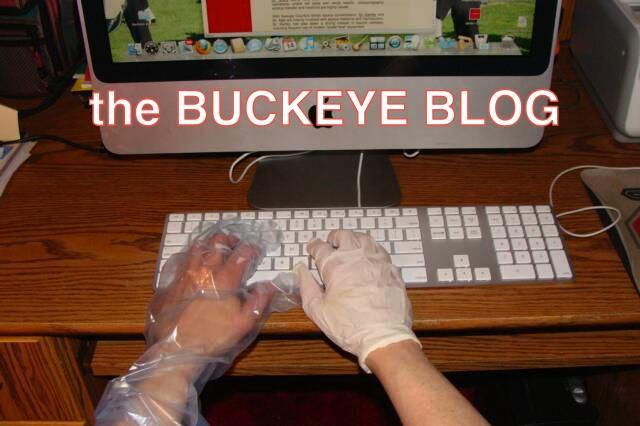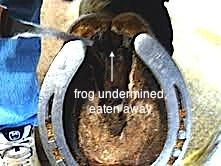SPARKLES' SULCUS STORY
- posted: Jun. 29, 2014

SPARKLES' SULCUS STORY by Ken Keckler DVM
Ms. Orslover is excited. After a long winter, a warm spring sun is shining, and she's going to be able to spend A LOT more time with her best equine buddy "Sparkles". Sparkles is excited too. He's been stuck in his stall due to snow and rain, and it's been difficult to keep his "house" dry. Even when he was turned out, since there was no grass, he typically waited at the gate to be brought back in, standing in the slush or mud.
As Sparkles is lead into the aisleway from his stall, Ms. Orslover notices a "bad step". Hmmm. Yes, he continues to get off that foot quickly. Ms. O clips Sparkles into the crossties and lifts his leg. She can't see much: his foot is packed full of manure and urine-soaked sawdust, clear up to the level of the shoe. Grabbing her handy-dandy hoofpick, she digs into the mass (which falls out in an oval puck of muck) and then pokes the tip of the pick into the crease alongside the frog. OUCH! As the pick goes deeper than Ms.O expected, Sparkles yanks the foot away and slams it to the ground, getting her britches dirty and barely missing her brand new paddock boots. On further examination, the creases that make the "V" shape around the frog are much deeper than normal and full of thick, black grunge. The center pocket of the frog is soft, looks "chewed up", and the black goo continues down into the heel. In addition, the area aggravated by the hoofpick is bleeding!
These deep crevices and the depression near the heel at the center of the frog are known as "SULCI" (plural): pronounced "sulk-eye". Just one of them is called a sulcus. So Sparkles (and most other horses) has a lateral (outside), a medial (inside), and a central sulcus in each foot.
As Ms. Orslover is pondering the latin root of the word "sulcus", and wondering if she will be able to impress her friends by using it in a sentence at the next PTA meeting, something terrible happens: she smells that black, oozy substance that came from Sparkles' foot. UGH! That's nasty! Smells like rotten, infected, putridness. And now it's on her hands and pants. And guess what: that odor won't come off with even the most vigorous hand washing.
Ms. Orslover and Sparkles are the victims of an insidious, potentially lameness causing infection, commonly known as "THRUSH"!
While not life threatening, this mixed infection with bacterial, yeast, and fungal components can cause chronic lameness and chronic aggravation. Afflicted horses typically have moist soles (likely from a wet environment) and frequently are narrow in the heel with a recessed frog. This conformation doesn't allow the frog to make consistent contact with the ground, so the heel doesn't expand and contract to allow debris to fall from the foot. Often these horses have been stall-bound and have not had the opportunity to run and send the "hoof packing" flying.
This foot has thrush that has undermined deep into the central sulcus causing it to appear shredded, and it is working its' way up between the heel bulbs.
If there is only thrush in one foot, it may be because the horse has been bearing less weight on that hoof due to discomfort. This can cause the heel to contract and the frog to recess, thereby making it more likely to retain debris and moisture.
Treating the thrush infection is simple enough: expose it to air and remove the moisture. This can be easier said than done. The frog can have multiple undermining tracts that deeply penetrate. Any overlapping tissue needs to be removed until the depths of the blackness has been uncovered. The medial and lateral sulci need to be opened up and cleaned, as typically a lip has developed that shelters the infection in the bottom of the crevice. Your veterinarian or farrier can trim away infected and eroded tissue with a sharp hoof knife. Your job is to clean the foot well, with soap and water and a toothbrush (or other appropriate scrubbing device), and dry it before applying medication.

There are many topical treatments, but they all are products that potentially kill bacteria/fungi and dessicate (dry) the tissue. Due to the caustic nature of many medications, great care should be taken to limit exposure to the frog and sole: the coronet band and skin would likely be chemically burned, or at least, very irritated. Your hands should be protected as well as these liquids can stain and aggravate your skin: wear gloves. In most cases, I use cotton soaked with 7% Iodine, and pack it into the sulci. Wrapping with vetrap and ductape, the owner changes the dressing every day for a week. Most likely the affliction will be cleaned up by then. If the black, foul smelling goo is not resolved, be sure that the eaten away frog is cleaned up, and try a different topical product (following label directions). White Lightning, Cleantrax, Kopertox, and Thrushbuster, just to name a few, along with any number of other home remedies. Please consult your veterinarian and/or blacksmith prior to using a non-brand name product.
After the initial problem is cleaned up, twice a week application of medication is usually sufficient to keep thrush at bay. Use a syringe or a pointed bottle tip to get it into the cracks, and again, be careful not to get it on your horse's skin. Another method is to wrap the tip of your hoofpick with a thin layer of cotton, soak it with the treatment, and squish it into deeper areas.
If the degradation is deep enough to penetrate into sensitive tissues (like Sparkle's bleeding foot) a tetanus vaccine is in order, and systemic antibiotics may be recommended. Your farrier may be able to improve narrow heels and deep frogs by trimming back the heels, applying a larger shoe, and placing frog supporting pads to help provide more normal pressure. In the perfect world, the frog should contact the ground with every step. This is also easier said than done! Remember, shoeing changes may take time to work, and any lameness issues should be addressed. If the infected fissures and clefts are not laid bare, cleaned, and decontaminated, the thrush will not be beaten.
Ms. Orselover begins to clean Sparkles' soles everyday. Her blacksmith trims out the compromised frog, and she treats the foot topically for seven days. With a concerted effort to keep the stall clean and dry, and judicious use of ductape, Sparkles' feet are soon sparkling. No more foul, repulsive, odor clinging to her hands and clothes! Sparkles is happy and Ms. Orslover is excited to be able to ride again!
Location
Find us on the map
16295 Claridon Troy Road
Burton, OH 44021, US
Office Hours
24 Hour Emergency Care - 365 Days a Year
8:00 am - 4:30 pm
8:00 am - 4:30 pm
8:00 am - 4:30 pm
8:00 am - 4:30 pm
8:00 am - 4:30 pm
Emergencies Only
Emergencies Only

